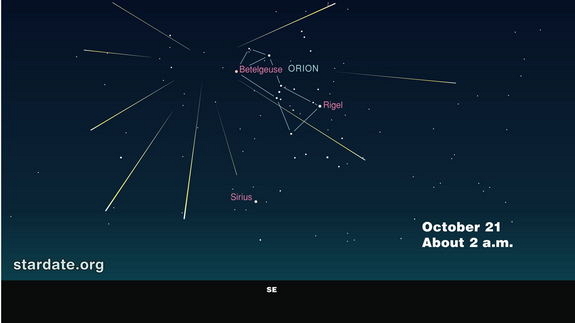

| Visitors Now: | |
| Total Visits: | |
| Total Stories: |

| Story Views | |
| Now: | |
| Last Hour: | |
| Last 24 Hours: | |
| Total: | |
“How to Watch the Orionid Meteor Shower This Weekend”
By Adam Mann
“One of the most spectacular night-sky shows will kick into high gear this weekend when the Orionid meteor shower peaks early in the morning on Oct. 20. It will continue to dazzle until just before dawn on the 21st. The Orionids are cosmic leftovers — bits of rock and ice that remain behind from Halley’s comet, which last passed through the inner solar system in 1986. As the sun heated the famous comet, chunks of debris broke off, leaving a trail of material that the Earth passes through annually. The pieces hit the Earth’s atmosphere at 148,000 mph, burning up and leaving trails that sometimes shine green or orange.
Conditions for this year’s shower should be very promising, with the sliver of a first-quarter moon setting around midnight, leaving the night sky exceedingly dark. To watch the meteors, you can take a nice warm blanket out to an area far from city lights, like a state park, and lie back to get a good full-sky view. You can expect around 25 meteors to shoot overhead per hour during the shower. The Orionids appear to come from the constellation Orion, familiar to even casual night sky viewers because of his recognizable three-star belt. Just above the belt is a bright orange star called Betelgeuse, sometimes known as Orion’s armpit. The Orionid meteors should streak from there.
This year’s celestial show will be joined by several planets, which can be distinguished from other stars by the fact that they don’t twinkle. Jupiter and Venus, the brightest objects in the night sky, will be arranged in a triangular configuration with Sirius, the Dog Star, during the pre-dawn moments of Oct. 21. Mars should also be visible as a red object in the southwest shortly after sunset both nights.
For city-bound folks, the show can be watched online. NASA will a host a webcast the night of Oct. 20 starting at 8 p.m. PDT/11 p.m. EDT and continuing for three hours until Sunday morning. Astronomer Mitzi Adams will answer questions during the broadcast.”
2012-10-21 04:23:24
Source:



